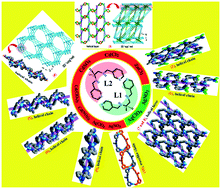A series of helical coordination polymers based on two racemic bis(pyridylmethylene) propane-1,2-diamine ligands: relationship of conformations, structures and properties†
Abstract
Helical coordination polymers have recently gained significant interest due to their unique architectures and potential applications to date. In this work, the self-assembly of different d10 metal salts and two racemic ligands with one chiral carbon generates ten complexes, namely, [M2(L2)Cl4]n [M = Zn (1 and 2) or Cd (3)], [Cd(L2)(SO4)]n (4), [Cd(L2)(X)(H2O)]n·nX [X = ClO4 (5) or NO3 (6)], [Ag(L1)]n·nClO4 (7), [Ag(L1)]n·nNO3·nH2O (8), [Ag(L2)]n·nClO4 (9) and [Ag(H2L2)]n·3nNO3·2nH2O (10) (L1 = N,N′-bis(pyridin-4-ylmethyl)propane-1,2-diamine, L2 = N,N′-bis(pyridin-3-ylmethyl)propane-1,2-diamine). Structural analyses indicate that except for the wave-like chain structure of complex 10 originating from the protonated H2L2+ ligand, the other complexes 1–9 all contain helical chains or helical layer structures with the pitches falling in the range of 7.97–19.76 Å. In particular, complexes 3 and 4 present different 3D sqc and uog nets, which are constructed from (Cd–Cl)n helical layers and (Cd–L2)n helical chains, respectively. Complexes 7 and 8 exhibit the same (4,4) layer incorporating homo-helical chains. These results show that the diverse conformations of two racemic ligands are highly responsible for the formation of helical architectures and even some chiral structures. The chirality of complexes 4, 5, 7 and 8 was further demonstrated by circular dichroism (CD) spectroscopy. Luminescence investigations revealed that the Zn(II) and Cd(II)-based complexes 1–6 exhibit blue emission maxima varying from 417 to 483 nm in the solid state at room temperature. Moreover, complexes 4 and 6 show average luminescence lifetimes of 8.87 (4) and 24.28 ns (6).



 Please wait while we load your content...
Please wait while we load your content...